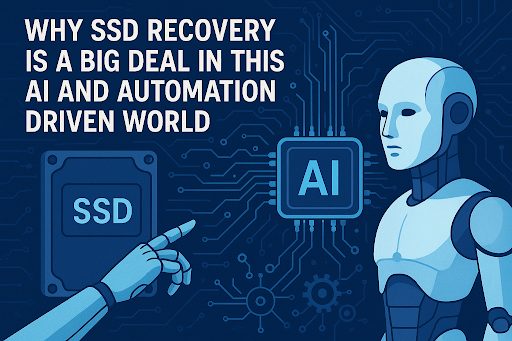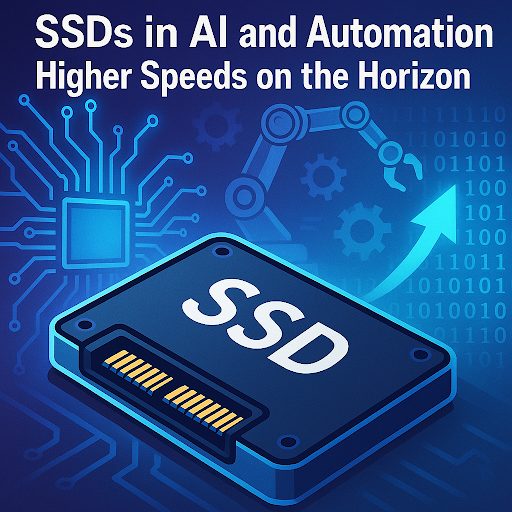
In an AI-, automation-, and intelligent chatbot-driven world, data is the new oil — and SSDs (Solid State Drives) act as the sleek, fast-moving pipelines that transfer and refine this resource from its source. Whether AI algorithms are learning from input from users, chatbots and voice assistants are being trained based on data that’s being logged, or customers are interacting with applications in real-time, businesses these days are utterly reliant on data recovery and processed just as quickly as it comes in, and so far as storage goes, this means it needs to be on SSDs.
Yet, no system is foolproof. While SSDs will tend to be more reliable than HDDs, they are by no means immune to failure. When that happens, SSD recovery can be an indispensable tool for maintaining continuity and safeguarding your most important digital assets.
SSDs in AI and Automation: Higher Speeds on the Horizon
There are several reasons why SSDs have become popular storage for AI platforms, automated systems, and bots:
- Speed: SSDs are much faster in read and write operations than HDDs, which is a must-have in order to be able to process in real-time, as with chatbots and artificial intelligence engines.
- Reliability SSDs are, as there are no moving parts, more shock-resistant than hard drives, so when your system is on the go, the added protection of an SSD could be a point in its favor.
- Compactness: With their small size, SSDs are ideal for room-limited places like edge AI equipment and smart kiosks.
But as these advantages enhance performance, they also contribute to a reliance — and in so doing, to the potential effects of data loss.

Common Causes of SSD Failure
Knowing the causes of SSD failure is important so that you get to know when and how to recover the information from the storage system. Some of the most frequent reasons are:
- Firmware damage: Your firmware may become corrupt if there are bugs or an update is interrupted, which will lead the drive to be unreadable.
- Power surges: Unexpected shutdowns or electrical spikes can destroy data.
- Bad blocks: the more the cells have been used (especially writing and erasing) the higher the chance of a fault developing.
- Controller malfunction: The SSD controller plays a key role in converting commands from the computer into actions by the device. If it doesn’t work, the drive is not usable.
These are the kinds of things that can shut down smart AI platforms, bot replies, and automated workflows without notice.
Why Retrieving Lost Files From An SSD Is So Hard
Recovering an SSD is not as easy as an HDD recovery. Here’s why:
- TRIM Command: Another thing to take into account is that for most SSDs the CMD command allows to permanently erase any information of a deleted file to keep speed and speed in the best condition. This makes recovering deleted files almost impossible in some cases.
- Encryption of data: Many SSDs encrypt the data that they store. Without access to the controller, or the decryption keys, recovery can become significantly impeded.
- Wear-leveling algorithms: By spreading data across the memory cells, these procedures obscure the location of files for file recovery systems.
This is why professional data recovery services can be the only option for recovering lost or corrupted data on an SSD.
SSD Data Recovery in Bot Platforms
AI Chatbots, virtual assistants, and AI agents depend on a lot of stored data—be it historical chat logs, user preferences, or NLP model checkpoints. The loss of this data can cause:
- Lack of conversational memory and context
- Disrupted workflows, or, the automation of customer service
- Partial data and retraining of AI model
- Regulation in regulated industries and privacy requirements
When AI Agent conversation is the core functionality of platforms like Botsify, an SSD crash could result in loss of client trust, service disruption, and more.
Generate More Leads With Website & Messenger Chatbots
Gather quality leads on autopilot and 10x your ROI with automated chats
Prevent SSD Data Loss with Proactive Steps
Although no system is fail-safe, there are a few strategies businesses can implement to insulate themselves.
Regular Backups
Automate backups to the cloud or local storage for essential system files and user data.
UPS & Surge Protectors
Uninterruptible power supplies and surge protectors should also be used to prevent corruption as a result of unplanned power outages.
Monitoring Tools
Add support for SSD health monitoring that reports when a drive is worn out, overheating, or its SMART attributes change.
Firmware Updates
Update SDD firmware via manufacturer-provided means in order to prevent Interface bugs and/or vulnerabilities. These measures can help reduce the risk, but at the same time, when failure does happen, recovery needs to be fast and efficient.
Selecting a Good SSD Data Recovery Service
If in-house fixes or Do It Yourself software tools don’t work, it is important to consult a specialized recovery provider. Find a Service With:
- NAND Flash Recovery Knowledge Data Recovery From Flash Memories
- Advanced cleanroom facilities
- Works great with TRIM-enabled drives
- Conformance to data privacy regulations (such as GDPR, HIPAA)
One such option is available on this page, where you can learn more about professional recovery options tailored for SSD storage devices used in complex environments like automation platforms.

Signs That You Need SSD Data Recovery
Not sure if your SSD is in trouble? Look for the following warning signs:
- System fails to recognize the drive
- Frequent crashes or freezing when accessing certain files
- Drive appears with zero capacity
- Slow performance despite minimal usage
- Clicking or beeping sounds from an SSD with a controller
Once these symptoms appear, continuing to use the drive could worsen the problem. Disconnect it and contact a recovery professional immediately.
Indications You Need SSD Data Recovery

Not sure if your SSD is dying? These are danger signs to watch for:
- The drive is not recognized by the system
- There is one type of problem that pops up pretty frequently, and it’s what you can do when you open a particular file(s) but the app crashes or freezes.
- Drive shows with 0kb space available
- Is your device slow to the draw when it’s hardly being used?
- Noises such as clicking or beeping coming from an SSD with a controller
Once these signals appear, further use of the drive will only exacerbate the issue. Unplug it and carry it straight to a recovery professional.
The Future: AI-Powered Data Recovery?
Glad to know that AI is being used for the betterment of the data recovery process. Machine learning models are used in identifying patterns of failures, optimizing chip-level accessibility, and recovering data from damaged sectors.
In not so long, AI won’t just require data recovery services — possibly power them
Conclusion
In the world of high-speed, high-performance AI-enabled platforms like Botsify, SSDs give speed, reliability, and the raw horsepower behind seamless user experiences. But when these drives do fail, the results can be swift and devastating. Being aware of how complex an SSD may be and how valuable expert data recovery can help companies ride out the storm of digital disruption.
Are You Ready To SkyRocket Your Business With Our AI Chatbots
Click The Button Below And Gather Quality Leads With Botsify

